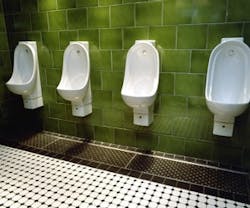5 Fast Facts about Waterless Urinals
Ever since waterless urinals were introduced in the 1980s, much debate has followed about their performance. Klaus Reichardt, founder of Waterless Co, highlights several potentials you should consider:
1. Cleanliness: Urine is sterile. Bacteria develop when urine is mixed with water. Waterless urinals not only eliminate flushing, but also water splashing onto floors or walls.
2. Odor: Waterless urinals use gravity to draw urine toward the drain and through a trap. The trap contains a liquid that allows urine to pass through while forming a seal against odors, like water passing through oil.
3. Maintenance: Traditional flush urinals often run into maintenance woes. Valves, for example, get jammed and either won’t move or will continuously flush. Waterless urinals have no flush values, sensors, or moving parts.
4. Water Savings: A traditional urinal uses anywhere from 1 to 3 gallons per flush, consuming up to 40,000 gallons annually. Depending on your area, the cost for every 1,000 gallons of water could be as low as $7 to as high as $25. Just one waterless urinal could put $280 back in your pocket.
5. Unit Expense: Waterless urinals cost $250-$500 a unit. Based on your water savings alone, your return on investment is less than two years. They can also help earn LEED credits and serve as a marketing tool.
Waterless urinals are a practical solution for facilities in drought-prone areas or with a high number of restrooms, recommends Reichardt. Encouraging users and updating maintenance training will ensure waterless urinals are a success in your building.
